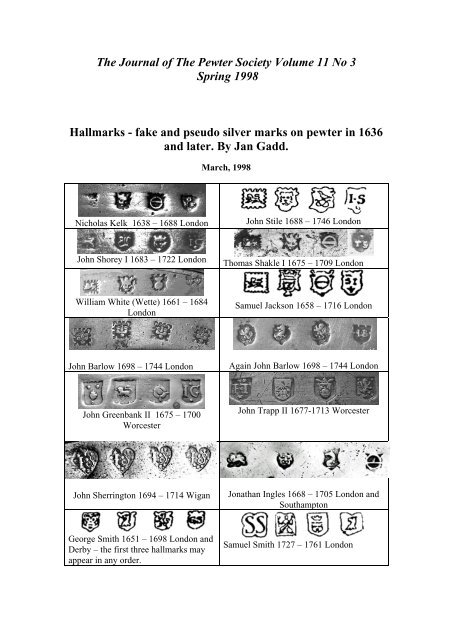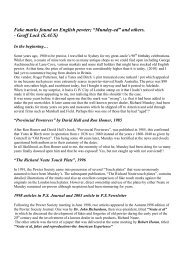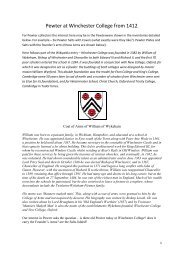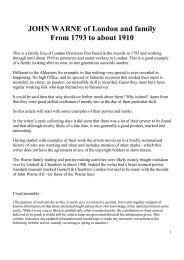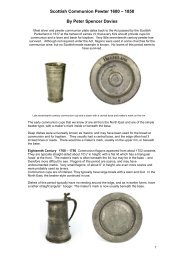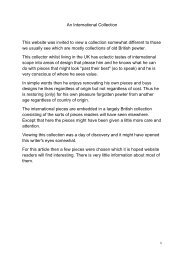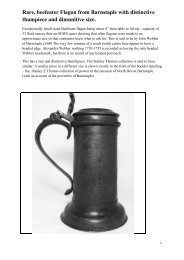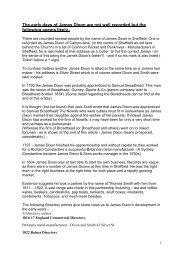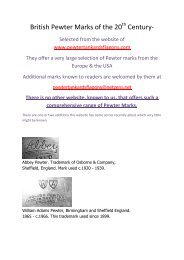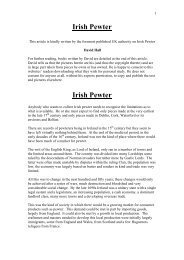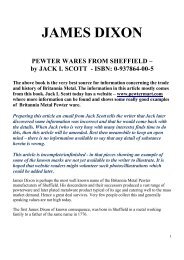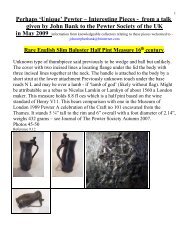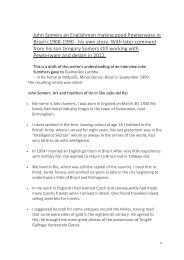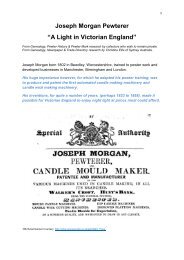Hallmarks - fake and pseudo silver marks on pewter in ... - PewterBank
Hallmarks - fake and pseudo silver marks on pewter in ... - PewterBank
Hallmarks - fake and pseudo silver marks on pewter in ... - PewterBank
You also want an ePaper? Increase the reach of your titles
YUMPU automatically turns print PDFs into web optimized ePapers that Google loves.
The Journal of The Pewter Society Volume 11 No 3<br />
Spr<strong>in</strong>g 1998<br />
<str<strong>on</strong>g>Hall<str<strong>on</strong>g>marks</str<strong>on</strong>g></str<strong>on</strong>g> - <str<strong>on</strong>g>fake</str<strong>on</strong>g> <str<strong>on</strong>g>and</str<strong>on</strong>g> <str<strong>on</strong>g>pseudo</str<strong>on</strong>g> <str<strong>on</strong>g>silver</str<strong>on</strong>g> <str<strong>on</strong>g>marks</str<strong>on</strong>g> <strong>on</strong> <strong>pewter</strong> <strong>in</strong> 1636<br />
<str<strong>on</strong>g>and</str<strong>on</strong>g> later. By Jan Gadd.<br />
March, 1998<br />
Nicholas Kelk 1638 – 1688 L<strong>on</strong>d<strong>on</strong><br />
John Stile 1688 – 1746 L<strong>on</strong>d<strong>on</strong><br />
John Shorey I 1683 – 1722 L<strong>on</strong>d<strong>on</strong><br />
Thomas Shakle I 1675 – 1709 L<strong>on</strong>d<strong>on</strong><br />
William White (Wette) 1661 – 1684<br />
L<strong>on</strong>d<strong>on</strong><br />
Samuel Jacks<strong>on</strong> 1658 – 1716 L<strong>on</strong>d<strong>on</strong><br />
John Barlow 1698 – 1744 L<strong>on</strong>d<strong>on</strong><br />
Aga<strong>in</strong> John Barlow 1698 – 1744 L<strong>on</strong>d<strong>on</strong><br />
John Greenbank II 1675 – 1700<br />
Worcester<br />
John Trapp II 1677-1713 Worcester<br />
John Sherr<strong>in</strong>gt<strong>on</strong> 1694 – 1714 Wigan<br />
J<strong>on</strong>athan Ingles 1668 – 1705 L<strong>on</strong>d<strong>on</strong> <str<strong>on</strong>g>and</str<strong>on</strong>g><br />
Southampt<strong>on</strong><br />
George Smith 1651 – 1698 L<strong>on</strong>d<strong>on</strong> <str<strong>on</strong>g>and</str<strong>on</strong>g><br />
Derby – the first three hall<str<strong>on</strong>g>marks</str<strong>on</strong>g> may<br />
appear <strong>in</strong> any order.<br />
Samuel Smith 1727 – 1761 L<strong>on</strong>d<strong>on</strong>
This is the year that the Goldsmiths' Company decided to take acti<strong>on</strong> both aga<strong>in</strong>st an<br />
<strong>in</strong>dividual <strong>pewter</strong>er <str<strong>on</strong>g>and</str<strong>on</strong>g> later <strong>in</strong> 1636 aga<strong>in</strong>st the Pewterer's Company for the<br />
malpractice of us<strong>in</strong>g <str<strong>on</strong>g>silver</str<strong>on</strong>g> hall<str<strong>on</strong>g>marks</str<strong>on</strong>g> <strong>on</strong> <strong>pewter</strong>.<br />
The librarian of the Goldsmiths' Company, Mr David Beasley, has k<strong>in</strong>dly researched<br />
this <strong>in</strong>cident from the Company's archives <str<strong>on</strong>g>and</str<strong>on</strong>g> given his permissi<strong>on</strong> for his<br />
observati<strong>on</strong>s to be published here:<br />
The details of the particular case are recorded <strong>in</strong> the Court M<strong>in</strong>utes of the<br />
Goldsmiths' Company. In the m<strong>in</strong>utes of the 12 January 1635/6 (Court M<strong>in</strong>ute Book<br />
S, part II, fo. 166r) a <strong>pewter</strong> trencher plate bear<strong>in</strong>g the leopard's head, the li<strong>on</strong> <str<strong>on</strong>g>and</str<strong>on</strong>g><br />
the letter "s" was put <strong>in</strong>to the h<str<strong>on</strong>g>and</str<strong>on</strong>g>s of the Wardens who were much c<strong>on</strong>cerned with<br />
the deceit which might practised, (those <str<strong>on</strong>g>marks</str<strong>on</strong>g> resembl<strong>in</strong>g those used <strong>on</strong> all plate <str<strong>on</strong>g>and</str<strong>on</strong>g><br />
vessels of <str<strong>on</strong>g>silver</str<strong>on</strong>g> to be marked at the Hall <strong>in</strong> this year). With the assistance of the<br />
K<strong>in</strong>g's Engraver of the M<strong>in</strong>t, Mr Greene, a warrant was to be processed aga<strong>in</strong>st the<br />
<strong>pewter</strong>er <str<strong>on</strong>g>and</str<strong>on</strong>g> the engraver of the stamps. Some m<strong>on</strong>ths later (7 July 1636) the Clerk<br />
reported that the <strong>pewter</strong>ers <str<strong>on</strong>g>and</str<strong>on</strong>g> the engraver of the stamps had all been prosecuted<br />
<str<strong>on</strong>g>and</str<strong>on</strong>g> had been f<strong>in</strong>ed. He requested that the trencher plate <strong>in</strong> questi<strong>on</strong> be returned to its<br />
owner <str<strong>on</strong>g>and</str<strong>on</strong>g> the counterfeit stamps kept <strong>in</strong> the Company's Treasury. An account of the<br />
Company's petiti<strong>on</strong> to the K<strong>in</strong>g <str<strong>on</strong>g>and</str<strong>on</strong>g> to the Lord Mayor <str<strong>on</strong>g>and</str<strong>on</strong>g> Court of Aldermen<br />
followed. The Pewterers' Company was required to order its members to strike <strong>on</strong>e<br />
mark <strong>on</strong>ly <strong>on</strong> their plate; to c<strong>on</strong>fiscate any stamps which were similar to the<br />
Goldsmiths <str<strong>on</strong>g>and</str<strong>on</strong>g> to h<str<strong>on</strong>g>and</str<strong>on</strong>g> them over to the Goldsmiths; <str<strong>on</strong>g>and</str<strong>on</strong>g> to melt down or deface the<br />
<str<strong>on</strong>g>marks</str<strong>on</strong>g> <strong>on</strong> all <strong>pewter</strong> currently bear<strong>in</strong>g those similar <str<strong>on</strong>g>marks</str<strong>on</strong>g>. (His order was dated the 3<br />
March 1635/6). The <strong>in</strong>dictment <strong>in</strong> Lat<strong>in</strong> followed - the names are <strong>in</strong> Lat<strong>in</strong> but may be<br />
Richard (Radus - Ricardus) - Hall, the engraver, <str<strong>on</strong>g>and</str<strong>on</strong>g> William Artyn, the <strong>pewter</strong>er<br />
(Court M<strong>in</strong>ute Book S, part II fo 209-211r.).<br />
Mr Beasley asked me to po<strong>in</strong>t out that his research covered the earlier period <strong>on</strong>ly <str<strong>on</strong>g>and</str<strong>on</strong>g><br />
that the Lat<strong>in</strong> names could be <strong>in</strong>terpreted differently.<br />
The Pewterers' Company-records suggest that the first offender's name was <strong>in</strong>deed<br />
William Artyne. He was from L<strong>on</strong>d<strong>on</strong> Thorpe <strong>in</strong> L<strong>in</strong>colnshire, was free <strong>in</strong> 1621 <str<strong>on</strong>g>and</str<strong>on</strong>g><br />
had his own shop <strong>in</strong> April 1622. He was apprenticed 1613-1621 to Peter Brocklesby<br />
I, together with Brocklesby's s<strong>on</strong>, Peter Brocklesby II, both guilty of similar <str<strong>on</strong>g>and</str<strong>on</strong>g> other<br />
offences as can be seen below.<br />
It is <strong>in</strong>terest<strong>in</strong>g to note that the engraver, logically, was f<strong>in</strong>ed as well as the <strong>pewter</strong>er!<br />
These engravers <str<strong>on</strong>g>and</str<strong>on</strong>g> die-makers would of course have supplied goldsmiths <str<strong>on</strong>g>and</str<strong>on</strong>g><br />
<strong>pewter</strong>ers alike.<br />
So severe, then, were the prospective c<strong>on</strong>sequences for the <strong>pewter</strong>ers <str<strong>on</strong>g>and</str<strong>on</strong>g> the potential<br />
disgrace for the Pewterers' Company that it must be regarded as highly unlikely that<br />
the practice was carried <strong>on</strong> systematically by officers of the Company <strong>in</strong> the follow<strong>in</strong>g<br />
decades! That the Goldsmiths still kept a watchful eye <strong>on</strong> counterfeit <strong>pewter</strong> is<br />
apparent from their Court Book dur<strong>in</strong>g the years of 1638, 1639 <str<strong>on</strong>g>and</str<strong>on</strong>g> 1643 where the
above Brocklesbys, who seem to have been "serial-offenders", appear twice. Under<br />
the date of July 21, 1638 (not July 20 as noted by Markham) it is stated that the full<br />
Court was not sitt<strong>in</strong>g:<br />
"... but tak<strong>in</strong>g <strong>in</strong>to c<strong>on</strong>siderati<strong>on</strong> the abuse of a <strong>pewter</strong>er <strong>in</strong> Holborn who setteth 4<br />
<str<strong>on</strong>g>marks</str<strong>on</strong>g> up<strong>on</strong> his <strong>pewter</strong> <strong>in</strong> resemblance of the <str<strong>on</strong>g>silver</str<strong>on</strong>g> touch by name Peter Brocklesby<br />
<strong>on</strong>e dish of whose mak<strong>in</strong>g was brought hither by Francis Baker, the engraver, who<br />
compla<strong>in</strong>s of the abuse here<strong>in</strong>, whereup<strong>on</strong> Mr Roberts, <strong>on</strong>e of the Wardens of the<br />
Pewterers was now sent for <str<strong>on</strong>g>and</str<strong>on</strong>g> after the clerk had read unto him the letter from the<br />
Lords of the Council directed unto Sir Christopher Clitherowe, late Lord Mayor of<br />
L<strong>on</strong>d<strong>on</strong> <str<strong>on</strong>g>and</str<strong>on</strong>g> the order of the Court of Aldermen made <strong>in</strong> that behalf he did<br />
acknowledge the same to be a great abuse."<br />
The Master <str<strong>on</strong>g>and</str<strong>on</strong>g> the other Warden Mr Fulham <str<strong>on</strong>g>and</str<strong>on</strong>g> Brooks of the Pewterers' Company<br />
were called <strong>in</strong> after the meet<strong>in</strong>g <str<strong>on</strong>g>and</str<strong>on</strong>g> were "acqua<strong>in</strong>ted with the matter" <str<strong>on</strong>g>and</str<strong>on</strong>g><br />
accompanied the Goldsmiths' Warden (the Master of the Goldsmiths' Company) <strong>on</strong><br />
the search. With such large <str<strong>on</strong>g>and</str<strong>on</strong>g> impressive entourage <strong>on</strong> the march, it was not at all<br />
surpris<strong>in</strong>g to note that Brocklesby had disappeared <str<strong>on</strong>g>and</str<strong>on</strong>g> with him the offend<strong>in</strong>g<br />
<strong>pewter</strong>. The search-party did, however, f<strong>in</strong>d <str<strong>on</strong>g>and</str<strong>on</strong>g> c<strong>on</strong>fiscate <str<strong>on</strong>g>silver</str<strong>on</strong>g> "pouns<strong>on</strong>s" <strong>in</strong> his<br />
absence. Up<strong>on</strong> their return to the Goldsmiths' Hall the <strong>pewter</strong>ers were told to "deal<br />
with the offender at the next meet<strong>in</strong>g." - all this <strong>in</strong> <strong>on</strong>e s<strong>in</strong>gle day!<br />
The Goldsmiths' pursued this case <str<strong>on</strong>g>and</str<strong>on</strong>g> could <strong>on</strong> June 22 (not June 20 as <strong>in</strong><br />
Markham/Prideaux), 1639 report to the Court of Assistants of the Goldsmiths'<br />
Company:<br />
"This day Mr Wardens receiv<strong>in</strong>g <strong>in</strong>formati<strong>on</strong> that Vaughan the graver <strong>in</strong> Kerry Lane<br />
had diverse parcels of <strong>pewter</strong> of <str<strong>on</strong>g>silver</str<strong>on</strong>g> fashi<strong>on</strong> <str<strong>on</strong>g>and</str<strong>on</strong>g> stamps with 4 <str<strong>on</strong>g>marks</str<strong>on</strong>g> <strong>in</strong><br />
resemblance of the <str<strong>on</strong>g>silver</str<strong>on</strong>g> touch....the said <strong>pewter</strong> be<strong>in</strong>g made <str<strong>on</strong>g>and</str<strong>on</strong>g> sold by <strong>on</strong>e Peter<br />
Brocklesby a <strong>pewter</strong>er next to St. Andrews Church <strong>in</strong> Holborn from whence the<br />
Master <str<strong>on</strong>g>and</str<strong>on</strong>g> Wardens of the Pewterers last year took the like stamps <str<strong>on</strong>g>and</str<strong>on</strong>g> delivered<br />
them to the last Wardens of this Company. [The Pewterers' Officers had such<br />
authority, whereas the Goldsmiths' Officers, also present <strong>on</strong> this occasi<strong>on</strong>, had no<br />
authority to <strong>in</strong>terfere with the <strong>in</strong>ventory of a <strong>pewter</strong>er.] And now Mr Wardens<br />
<strong>in</strong>tend<strong>in</strong>g to speak with the Master <str<strong>on</strong>g>and</str<strong>on</strong>g> Wardens of the Pewterers about this abuse<br />
they had noticed that this morn<strong>in</strong>g they were at Pewterers' Hall unto which place Mr<br />
Wardens repaired <str<strong>on</strong>g>and</str<strong>on</strong>g> took the graver with them <str<strong>on</strong>g>and</str<strong>on</strong>g> some pieces of <strong>pewter</strong> of<br />
several sorts by which it appeared that the said Brocklesby made the said <strong>pewter</strong><br />
although his mark was so defaced with the hammer that it was scarce discernible<br />
[probably his own touch rather than the hall<str<strong>on</strong>g>marks</str<strong>on</strong>g>] of which abuse Mr Wardens<br />
compla<strong>in</strong>ed to the Master <str<strong>on</strong>g>and</str<strong>on</strong>g> Warden of the Pewterers it be<strong>in</strong>g an offence aga<strong>in</strong>st an<br />
order of the Lord Mayor <str<strong>on</strong>g>and</str<strong>on</strong>g> the Court of Aldermen made 3rd of March 1635 granted<br />
up<strong>on</strong> a letter directed unto them from the Lords of the Council both which as they are<br />
entered <strong>in</strong> this Company's Court Book at a Court of Assistants holden the 7th of July<br />
1636. Mr Wardens did now course to be read unto them of which the Pewterers had<br />
l<strong>on</strong>g s<strong>in</strong>ce notice by a copy of the said order left with them <str<strong>on</strong>g>and</str<strong>on</strong>g> they did c<strong>on</strong>fess that<br />
the said order was read at their Hall at a General Meet<strong>in</strong>g <str<strong>on</strong>g>and</str<strong>on</strong>g> that the said Brocklesby<br />
had notice thereof the said Master <str<strong>on</strong>g>and</str<strong>on</strong>g> Wardens <str<strong>on</strong>g>and</str<strong>on</strong>g> some of the Assistants of the<br />
Pewterers protest<strong>in</strong>g they do not know any other which attempteth the like <str<strong>on</strong>g>and</str<strong>on</strong>g> they
do promise to give him notice <strong>on</strong>ce more of this compla<strong>in</strong>t <str<strong>on</strong>g>and</str<strong>on</strong>g> require a reformati<strong>on</strong><br />
thereof <str<strong>on</strong>g>and</str<strong>on</strong>g> if he will not obey the said order <str<strong>on</strong>g>and</str<strong>on</strong>g> their government they will assist this<br />
Company <strong>in</strong> their compla<strong>in</strong>t to the Court of Aldermen aga<strong>in</strong>st him but first will<br />
acqua<strong>in</strong>t this Company of their proceed<strong>in</strong>gs with him."<br />
(Vaughan had been commissi<strong>on</strong>ed by an owner to engrave his arms <strong>on</strong> Brocklesby's<br />
<strong>pewter</strong>.)<br />
Peter Brocklesby I appears as an offender <strong>in</strong> 1617-18 (Welch Vol. II, pp.74-75 - <strong>in</strong><br />
1616 accord<strong>in</strong>g to Markham p.111) when he was first ordered to "amend <str<strong>on</strong>g>and</str<strong>on</strong>g> make<br />
perfect his marke" (19th March) <str<strong>on</strong>g>and</str<strong>on</strong>g> later <strong>on</strong> 10th December was found to be <strong>in</strong><br />
breach of the order of the Court of Pewterers to use <strong>on</strong>e touch <strong>on</strong>ly (<strong>on</strong>e touch was<br />
then c<strong>on</strong>fiscated). Peter Brocklesby II was sued by the Pewterers' company "for<br />
arrears of m<strong>on</strong>ey due from him under his wardenship" when <strong>in</strong> 1638 he was serv<strong>in</strong>g<br />
as Upper Warden. This offence could be classified as "embezzlement" <str<strong>on</strong>g>and</str<strong>on</strong>g> was by far<br />
the more serious (Welch Vol II, p.101).<br />
Only <strong>on</strong>e further case is menti<strong>on</strong>ed <strong>in</strong> the Court Book of the Goldsmiths' Company <strong>on</strong><br />
August 31, 1643 when the Assayer, Mr Jacks<strong>on</strong>, produced before the Court a <strong>pewter</strong><br />
pot with hall<str<strong>on</strong>g>marks</str<strong>on</strong>g>.<br />
"... It is therefore ordered that Mr Jacks<strong>on</strong> shall cause another <strong>pewter</strong> pot to be bought<br />
<str<strong>on</strong>g>and</str<strong>on</strong>g> up<strong>on</strong> f<strong>in</strong>d<strong>in</strong>g out the offender then to proceed as shall be further directed by a<br />
Court of Assistants."<br />
The <strong>pewter</strong>er "appears to have been" Butcher of St. Ann's Lane. (Robert B. OP 750 or<br />
Thomas B. OP 751) The vagueness here seems to <strong>in</strong>dicate that the Assayer<br />
purchased the items from a retailer rather than directly from the <strong>pewter</strong>er This case<br />
does not appear to have come to Court <str<strong>on</strong>g>and</str<strong>on</strong>g> it can be assumed that the Assayer was<br />
unsuccessful <strong>in</strong> repeat<strong>in</strong>g the purchase directly from the offend<strong>in</strong>g <strong>pewter</strong>er.<br />
So why is it then that L<strong>on</strong>d<strong>on</strong> sadware often rout<strong>in</strong>ely carry similar hall<str<strong>on</strong>g>marks</str<strong>on</strong>g> over a<br />
l<strong>on</strong>g period of time (The probable start<strong>in</strong>g date of this praxis is much later than the<br />
above fraud cases. Evidence <strong>in</strong> the shape of hallmarked items po<strong>in</strong>t at a time after the<br />
Great Fire of L<strong>on</strong>d<strong>on</strong> or from the Restorati<strong>on</strong> <strong>in</strong> 1660.)<br />
One answer can be deduced from the above. Pewterer Artyne copied the L<strong>on</strong>d<strong>on</strong><br />
Goldsmiths' <str<strong>on</strong>g>marks</str<strong>on</strong>g> exactly, <strong>in</strong>clud<strong>in</strong>g the date-letter "s" for the current year, thus<br />
fraudulently follow<strong>in</strong>g the Ord<strong>in</strong>ance of the Goldsmiths' Company when mark<strong>in</strong>g his<br />
<strong>pewter</strong>ware, <str<strong>on</strong>g>and</str<strong>on</strong>g> therefore also break<strong>in</strong>g the laws of the l<str<strong>on</strong>g>and</str<strong>on</strong>g>! (Had Artyne also<br />
neglected to mark the <strong>pewter</strong> with his own touch, which is not clear, he would then<br />
have been <strong>in</strong> breach of the rules of the Pewterers' Company too.)<br />
C<strong>on</strong>trary to comm<strong>on</strong> belief, it would appear that the Pewterers' Company had very<br />
little to answer for dur<strong>in</strong>g the early period - it was evidently a family affair <strong>in</strong>volv<strong>in</strong>g<br />
run-of-the-mill <str<strong>on</strong>g>fake</str<strong>on</strong>g>rs sell<strong>in</strong>g <str<strong>on</strong>g>silver</str<strong>on</strong>g>-marked <strong>pewter</strong>.<br />
In "A History of Agriculture <str<strong>on</strong>g>and</str<strong>on</strong>g> Prices <strong>in</strong> Engl<str<strong>on</strong>g>and</str<strong>on</strong>g> 1259-1793", volume V cover<strong>in</strong>g<br />
the period 1583-1702, James Thorold Rogers states under "Pewter" that "Towards the
end of the period a new k<strong>in</strong>d of material for plates is quoted, under the name of hard<br />
metal... It costs from 18s. to 14s. the dozen, ord<strong>in</strong>ary <strong>pewter</strong> be<strong>in</strong>g quoted at 11s. the<br />
dozen pounds. Perhaps the material is the same as that which at 1s. 4d. the pound is<br />
spoken of <strong>in</strong> the year before (1695) as the new fashi<strong>on</strong> dish... The material is probably<br />
some late discovery."<br />
What is <strong>in</strong>terest<strong>in</strong>g here is not so much the prices, but the fact that the old style <strong>pewter</strong><br />
("ord<strong>in</strong>ary <strong>pewter</strong>" accord<strong>in</strong>g to Rogers) was available al<strong>on</strong>gside the new <str<strong>on</strong>g>and</str<strong>on</strong>g> more<br />
expensive hardmetal! (See also <strong>pewter</strong>ers' trade cards <strong>in</strong> OP, such as No. 19, p. 73 of<br />
William S<str<strong>on</strong>g>and</str<strong>on</strong>g>ys <str<strong>on</strong>g>and</str<strong>on</strong>g> many others, pay<strong>in</strong>g tribute to Jaques Taud<strong>in</strong> <str<strong>on</strong>g>and</str<strong>on</strong>g> the "French<br />
<strong>pewter</strong>".)<br />
Would it then not be logical for the L<strong>on</strong>d<strong>on</strong> <strong>pewter</strong>ers to dist<strong>in</strong>guish the new, <str<strong>on</strong>g>silver</str<strong>on</strong>g>y<br />
hardmetal <strong>pewter</strong> with the modified hall<str<strong>on</strong>g>marks</str<strong>on</strong>g>, <strong>in</strong> additi<strong>on</strong> to the small crowned X we<br />
usually associate with the new alloy - how else could the customers know the<br />
difference dur<strong>in</strong>g these early days<br />
The Li<strong>on</strong> Passant was the Sterl<strong>in</strong>g Silver quality mark <str<strong>on</strong>g>and</str<strong>on</strong>g> the L<strong>on</strong>d<strong>on</strong> town mark of<br />
the leopard's head was, if crowned, referred to as the "K<strong>in</strong>g's Mark" (from the royal<br />
arms) <str<strong>on</strong>g>and</str<strong>on</strong>g> used by the Goldsmiths' with the Sterl<strong>in</strong>g Li<strong>on</strong>. Several Masters <str<strong>on</strong>g>and</str<strong>on</strong>g> senior<br />
officers of the Pewterers' Company did use these very <str<strong>on</strong>g>marks</str<strong>on</strong>g> as their Nos. 1. <str<strong>on</strong>g>and</str<strong>on</strong>g> 2. as<br />
did William Artyne <strong>in</strong> 1636. It seems, however, that the <strong>pewter</strong>ers eventually found<br />
themselves a legal loophole. A third device was added <str<strong>on</strong>g>and</str<strong>on</strong>g> (current year's) dateletter<br />
avoided or the <str<strong>on</strong>g>marks</str<strong>on</strong>g> were all or mostly <strong>in</strong>dividual <strong>in</strong>venti<strong>on</strong>s. No lawyer, even today,<br />
would accept to challenge <strong>in</strong> court such modified hall<str<strong>on</strong>g>marks</str<strong>on</strong>g>, especially as they were<br />
now always accompanied by the required touch <str<strong>on</strong>g>and</str<strong>on</strong>g> by other <str<strong>on</strong>g>marks</str<strong>on</strong>g>. That is perhaps<br />
the reas<strong>on</strong> why the Goldsmiths never aga<strong>in</strong> challenged the <strong>pewter</strong>ers<br />
Three-times Master Nicholas Kelk, Master John Stile, Upper Warden John Shorey,<br />
(f<strong>in</strong>ed Master) Thomas Shakle <str<strong>on</strong>g>and</str<strong>on</strong>g> William White (Wette) all used the above<br />
li<strong>on</strong>/leopard's head-comb<strong>in</strong>ati<strong>on</strong> for their hall<str<strong>on</strong>g>marks</str<strong>on</strong>g>' Nos.1 <str<strong>on</strong>g>and</str<strong>on</strong>g> 2 as did many others,<br />
although sometimes "scrambled". Kelk <str<strong>on</strong>g>and</str<strong>on</strong>g> Shakle used a buckle as their No. 3. (Mr<br />
Beasley <strong>in</strong>formed me that versi<strong>on</strong>s of a buckle always formed part of the arms of the<br />
Goldsmiths' Company.) Stile <str<strong>on</strong>g>and</str<strong>on</strong>g> Shorey used versi<strong>on</strong>s of a bird <str<strong>on</strong>g>and</str<strong>on</strong>g> William White a<br />
thistle as their No. 3, thus seem<strong>in</strong>gly avoid<strong>in</strong>g the renewed wrath of the mighty<br />
Goldsmiths Company.<br />
The early <str<strong>on</strong>g>and</str<strong>on</strong>g> small hall<str<strong>on</strong>g>marks</str<strong>on</strong>g> used by the <strong>pewter</strong>ers (c. 1670-1680) co<strong>in</strong>cide <strong>in</strong> size<br />
with the <str<strong>on</strong>g>silver</str<strong>on</strong>g>smiths' <str<strong>on</strong>g>marks</str<strong>on</strong>g>. The height of the crowned leopard's head-punch, for<br />
<strong>in</strong>stance, seems to average some 5.5 mm <strong>in</strong> height <strong>on</strong> both <str<strong>on</strong>g>silver</str<strong>on</strong>g> <str<strong>on</strong>g>and</str<strong>on</strong>g> <strong>pewter</strong> items of<br />
this period. The fact that these early sets of <strong>pewter</strong>ers' four hall<str<strong>on</strong>g>marks</str<strong>on</strong>g> all had<br />
<strong>in</strong>dividual shield-outl<strong>in</strong>e suggests that they were purchased as an off-the-shelf item<br />
from die-makers, such as Richard Hall, who also supplied the <str<strong>on</strong>g>silver</str<strong>on</strong>g>smiths with their<br />
punches. Had these <strong>pewter</strong>ers especially ordered complete sets from a die-maker, the<br />
shield-outl<strong>in</strong>e would logically be the same for each mark <strong>in</strong> a set. Kelk, Stile, Shakle<br />
<str<strong>on</strong>g>and</str<strong>on</strong>g> William White (menti<strong>on</strong>ed above) all seem to have identical dies for their No. 2<br />
leopard's head, crowned (see illustrati<strong>on</strong>s). These dies have the same elaborate<br />
outl<strong>in</strong>e, follow<strong>in</strong>g the outl<strong>in</strong>e of both crown <str<strong>on</strong>g>and</str<strong>on</strong>g> head. The crowns all have three<br />
po<strong>in</strong>ted "ears" which with wear give a stylised wolf-impressi<strong>on</strong>. The ch<strong>in</strong>s of the li<strong>on</strong>s
are decidedly po<strong>in</strong>ted. John Stile, <str<strong>on</strong>g>and</str<strong>on</strong>g> Thos. Shakle used identical punches for their<br />
No. 1 li<strong>on</strong> passant (<str<strong>on</strong>g>and</str<strong>on</strong>g> probably William White/Wette too). From Cotterell's<br />
draw<strong>in</strong>gs under OP 5741 it would appear that five times Master Samuel Jacks<strong>on</strong> too<br />
used identical punches <str<strong>on</strong>g>and</str<strong>on</strong>g> die-maker as did Kelk <str<strong>on</strong>g>and</str<strong>on</strong>g> Shakle, for his HMs Nos. 1-3<br />
There is a certa<strong>in</strong> "generati<strong>on</strong>-gap" between some of the <strong>pewter</strong>ers above, which<br />
could <strong>in</strong>dicate a take-over or purchase of punches. There is, however, enough<br />
evidence here to suggest that the same die-maker supplied several L<strong>on</strong>d<strong>on</strong> <strong>pewter</strong>ers<br />
with more or less identical punches dur<strong>in</strong>g this period.<br />
Another comb<strong>in</strong>ati<strong>on</strong> of <str<strong>on</strong>g>silver</str<strong>on</strong>g> hall<str<strong>on</strong>g>marks</str<strong>on</strong>g> appeared <strong>in</strong> 1696/97 denot<strong>in</strong>g the Britannia<br />
St<str<strong>on</strong>g>and</str<strong>on</strong>g>ard with higher <str<strong>on</strong>g>silver</str<strong>on</strong>g> c<strong>on</strong>tent. This st<str<strong>on</strong>g>and</str<strong>on</strong>g>ard replaced Sterl<strong>in</strong>g until 1718/19 <str<strong>on</strong>g>and</str<strong>on</strong>g><br />
was <strong>in</strong>troduced to prevent the melt<strong>in</strong>g down of the co<strong>in</strong>age for c<strong>on</strong>versi<strong>on</strong> <strong>in</strong>to plate.<br />
(This preventive move was very clever, as such melted down Sterl<strong>in</strong>g plate would not<br />
comply with the Britannia <str<strong>on</strong>g>silver</str<strong>on</strong>g> St<str<strong>on</strong>g>and</str<strong>on</strong>g>ard dur<strong>in</strong>g this period.) The <str<strong>on</strong>g>silver</str<strong>on</strong>g> <str<strong>on</strong>g>marks</str<strong>on</strong>g> were<br />
those of the seated figure of Britannia <strong>in</strong> comb<strong>in</strong>ati<strong>on</strong> with the Li<strong>on</strong>'s head erased (<strong>in</strong><br />
profile with a jagged neck). The <str<strong>on</strong>g>silver</str<strong>on</strong>g>smiths used their <strong>in</strong>itials <strong>on</strong> their Sterl<strong>in</strong>g <str<strong>on</strong>g>silver</str<strong>on</strong>g><br />
before <str<strong>on</strong>g>and</str<strong>on</strong>g> after the above dates but the first two letters of their surname dur<strong>in</strong>g the<br />
Britannia <str<strong>on</strong>g>silver</str<strong>on</strong>g> period. The famous Huguenot <str<strong>on</strong>g>silver</str<strong>on</strong>g>smith Paul de Lamerie's mark <strong>on</strong><br />
his Sterl<strong>in</strong>g <str<strong>on</strong>g>silver</str<strong>on</strong>g> was P.L.[Grimwade No. 2203] but earlier, <strong>in</strong> comb<strong>in</strong>ati<strong>on</strong> with the<br />
Britannia <str<strong>on</strong>g>marks</str<strong>on</strong>g>, "LA" [Grimwade No. 1892]. All <str<strong>on</strong>g>marks</str<strong>on</strong>g> with the excepti<strong>on</strong> of the<br />
<str<strong>on</strong>g>silver</str<strong>on</strong>g>smith's own mark were struck by assay officers at the Hall.<br />
This comb<strong>in</strong>ati<strong>on</strong> of <str<strong>on</strong>g>marks</str<strong>on</strong>g> too was used by a "third generati<strong>on</strong>" of hardmetal<br />
<strong>pewter</strong>ers, aga<strong>in</strong> always with an added device <str<strong>on</strong>g>and</str<strong>on</strong>g> without a dateletter. The <strong>in</strong>nocence<br />
of the <strong>pewter</strong>ers is here often dem<strong>on</strong>strated by their use of an unholy blend of<br />
Britannia <str<strong>on</strong>g>and</str<strong>on</strong>g> Sterl<strong>in</strong>g symbols <strong>in</strong> the same set of hall<str<strong>on</strong>g>marks</str<strong>on</strong>g> which could not possibly<br />
be c<strong>on</strong>strued as a "fraudulent use of <str<strong>on</strong>g>silver</str<strong>on</strong>g> hall<str<strong>on</strong>g>marks</str<strong>on</strong>g>"! A set of four unrecorded<br />
hall<str<strong>on</strong>g>marks</str<strong>on</strong>g> of this period, all with<strong>in</strong> the same shield outl<strong>in</strong>e by John Barlow of L<strong>on</strong>d<strong>on</strong><br />
(<strong>on</strong> a 20 ¼" charger with Swedish provenance), have the li<strong>on</strong>'s head erased repeated<br />
twice as Nos.1 <str<strong>on</strong>g>and</str<strong>on</strong>g> 3 which saved the <strong>pewter</strong>er some m<strong>on</strong>ey (see illustrati<strong>on</strong>). This<br />
comb<strong>in</strong>ati<strong>on</strong> avoids the Britannia figure <str<strong>on</strong>g>and</str<strong>on</strong>g> shows <strong>in</strong>stead a li<strong>on</strong> rampant. This li<strong>on</strong><br />
rampant was struck twice as Nos. 1 <str<strong>on</strong>g>and</str<strong>on</strong>g> 3 <strong>in</strong> Cotterell's example <strong>in</strong> OP No. 256 <str<strong>on</strong>g>and</str<strong>on</strong>g><br />
the li<strong>on</strong>'s head erased is here struck <strong>on</strong>ce as No. 2, aga<strong>in</strong> avoid<strong>in</strong>g the cost of a fourth<br />
die for Mr Barlow. The dist<strong>in</strong>ctive outl<strong>in</strong>e of Barlow's identical shields is<br />
unfortunately blurred (as always with the shields) <strong>in</strong> Cotterell's OP-illustrati<strong>on</strong>s!<br />
Prov<strong>in</strong>cial <strong>pewter</strong>ers like John Greenbank III <str<strong>on</strong>g>and</str<strong>on</strong>g> John Trapp II (see illustrati<strong>on</strong>) of<br />
Worcester very often used comb<strong>in</strong>ati<strong>on</strong>s of four different hall<str<strong>on</strong>g>marks</str<strong>on</strong>g> with<strong>in</strong> identical<br />
shields. The logic here to expla<strong>in</strong> such extravagance would be that they had to order a<br />
tailor-made set locally (or possibly from L<strong>on</strong>d<strong>on</strong>), whereas the L<strong>on</strong>d<strong>on</strong> makers had<br />
an ample choice of specialist die-makers <str<strong>on</strong>g>and</str<strong>on</strong>g> could buy <strong>in</strong>dividual punches "off-theshelf."<br />
John Sher<strong>in</strong>gt<strong>on</strong> of Wigan struck the same mark four times, much to the same<br />
effect (see illustrati<strong>on</strong>).<br />
The appearance of Britannia <str<strong>on</strong>g>and</str<strong>on</strong>g>/or the Li<strong>on</strong>'s head erased <strong>in</strong> a set of <strong>pewter</strong><br />
hall<str<strong>on</strong>g>marks</str<strong>on</strong>g> could be an useful aid <strong>in</strong> dat<strong>in</strong>g as they ought not logically to be found <strong>on</strong><br />
<strong>pewter</strong> items earlier than c. 1700<br />
Both Markham <strong>in</strong> 1909 <str<strong>on</strong>g>and</str<strong>on</strong>g> later Cotterell (with reservati<strong>on</strong>s) wr<strong>on</strong>gly assumed that
hallmark<strong>in</strong>g was comm<strong>on</strong> practice by <strong>pewter</strong>ers from 1636 <strong>on</strong>wards. Cotterell, hav<strong>in</strong>g<br />
accepted the statements of Markham/Prideaux about this "comm<strong>on</strong> practice from<br />
1636", was probably very c<strong>on</strong>fused <strong>in</strong>deed <strong>in</strong> the face of overwhelm<strong>in</strong>g hallmark<br />
evidence to the c<strong>on</strong>trary before him - see OP page 51, last sentence of the sec<strong>on</strong>d<br />
paragraph under "Hall-Marks".<br />
Markham states <strong>on</strong> p. 23 : "Although the Pewterers, as a company, professed<br />
obedience to this [order], as to other orders, it does not appear that the Pewterers, as<br />
<strong>in</strong>dividuals, paid the slightest attenti<strong>on</strong> to them." (The first "case" <strong>in</strong> 1601 quoted by<br />
Markham from Prideaux is, strangely, a case where a latten spo<strong>on</strong> had been found<br />
with <str<strong>on</strong>g>marks</str<strong>on</strong>g> nearly resembl<strong>in</strong>g the touch <str<strong>on</strong>g>and</str<strong>on</strong>g> no acti<strong>on</strong> taken.) Cotterell states <strong>in</strong> OP p.<br />
51 "....the Company was <strong>in</strong> c<strong>on</strong>stant trouble with the Goldsmiths over them, which <strong>in</strong><br />
1635 culm<strong>in</strong>ated <strong>in</strong> the Court of Aldermen forbidd<strong>in</strong>g their use by the Pewterers."<br />
The evidence <strong>on</strong> rema<strong>in</strong><strong>in</strong>g sadware, however, is as clear to us as to Cotterell, <str<strong>on</strong>g>and</str<strong>on</strong>g> it<br />
tells us that the Goldsmiths' order was very well observed <strong>in</strong>deed with just a few<br />
excepti<strong>on</strong>s as described (<str<strong>on</strong>g>and</str<strong>on</strong>g> a few others, no doubt), until the later period menti<strong>on</strong>ed<br />
above. Cotterell further states <strong>on</strong> the above page, aga<strong>in</strong> presumably utterly c<strong>on</strong>fused<br />
that "...for neither had they [the hall<str<strong>on</strong>g>marks</str<strong>on</strong>g>] c<strong>on</strong>nexi<strong>on</strong> with, nor were they <strong>in</strong> any way<br />
recognised by, the Authorities at Pewterers' Hall". These very "Authorities" from<br />
successive Masters down did, however, use the "modified" hall<str<strong>on</strong>g>marks</str<strong>on</strong>g> with some gusto<br />
<strong>on</strong> hardmetal sadware from this later date, as Cotterell must have been very well<br />
aware of <strong>in</strong>deed!<br />
C<strong>on</strong>clusi<strong>on</strong><br />
The assumpti<strong>on</strong> that hall<str<strong>on</strong>g>marks</str<strong>on</strong>g> were widely used by <strong>pewter</strong>ers from 1636 (<str<strong>on</strong>g>and</str<strong>on</strong>g> earlier)<br />
seems to the author to be utterly wr<strong>on</strong>g. The Goldsmiths' Company did <strong>in</strong> fact<br />
diligently <str<strong>on</strong>g>and</str<strong>on</strong>g> efficiently pursue each <str<strong>on</strong>g>and</str<strong>on</strong>g> every case of fraudulent use of <str<strong>on</strong>g>silver</str<strong>on</strong>g><br />
hall<str<strong>on</strong>g>marks</str<strong>on</strong>g> they came across, as has been seen above. Had it not been for the notorious<br />
Brocklesbys, the sum total of offences dealt with by the Goldsmiths' Court would, <strong>in</strong><br />
fact, have been reduced by fifty percent. It should also be noted that the <strong>in</strong>formers<br />
were mostly h<strong>on</strong>est engravers <str<strong>on</strong>g>and</str<strong>on</strong>g> die-makers such as Francis Baker <str<strong>on</strong>g>and</str<strong>on</strong>g> Vaughan<br />
above. Their allegiance to the Goldsmiths, who provided the bulk of their work is<br />
obvious, although the fraudsters will<strong>in</strong>g to make <str<strong>on</strong>g>fake</str<strong>on</strong>g> touches could be found am<strong>on</strong>gst<br />
their ranks, such as Richard Hall, menti<strong>on</strong>ed <strong>in</strong> the first case above. Pewterers<br />
fraudulently mark<strong>in</strong>g their ware with the <str<strong>on</strong>g>silver</str<strong>on</strong>g> <str<strong>on</strong>g>marks</str<strong>on</strong>g> were of course permanently<br />
runn<strong>in</strong>g the risk of be<strong>in</strong>g caught by engravers loyal to the Goldsmiths, commissi<strong>on</strong>ed<br />
by <strong>pewter</strong> owners to engrave names <str<strong>on</strong>g>and</str<strong>on</strong>g> arms.<br />
The hall<str<strong>on</strong>g>marks</str<strong>on</strong>g> used by the <strong>pewter</strong>ers dur<strong>in</strong>g the Golden Age of first L<strong>on</strong>d<strong>on</strong> <str<strong>on</strong>g>and</str<strong>on</strong>g> later<br />
prov<strong>in</strong>cial <strong>pewter</strong> from c.1660-1665 <strong>on</strong> the L<strong>on</strong>d<strong>on</strong> hardmetal <strong>pewter</strong>, did not <strong>in</strong>fr<strong>in</strong>ge<br />
the rules of the Goldsmiths' Assay Hall as has been shown above.<br />
Some items do exist with the "legal" hall<str<strong>on</strong>g>marks</str<strong>on</strong>g> <strong>on</strong> older style of <strong>pewter</strong> items. Such<br />
items by often unidentified/prov<strong>in</strong>cial <strong>pewter</strong>ers are sometimes dated c.1650 because<br />
of this older style. These items could of course be later <str<strong>on</strong>g>and</str<strong>on</strong>g> simply illustrate a<br />
prol<strong>on</strong>ged use of the older style moulds which would especially be the case with<br />
prov<strong>in</strong>cial <strong>pewter</strong>ers.
Acknowledgement <str<strong>on</strong>g>and</str<strong>on</strong>g> reference<br />
- The Worshipful Company of Goldsmiths: i. Court M<strong>in</strong>ute Book T, ff.111 r-v ; ii. Court<br />
M<strong>in</strong>ute Book V, ff.1 v -2 r ; iii. Court M<strong>in</strong>ute Book W ff.87 v -88 r . Spell<strong>in</strong>g <str<strong>on</strong>g>and</str<strong>on</strong>g><br />
punctuati<strong>on</strong> has been modernised.<br />
- Corresp<strong>on</strong>dence <str<strong>on</strong>g>and</str<strong>on</strong>g> c<strong>on</strong>versati<strong>on</strong>s <strong>in</strong> November 1997 with Mr David Beasley,<br />
librarian of the Worshipful Company of Goldsmiths, <str<strong>on</strong>g>and</str<strong>on</strong>g> c<strong>on</strong>versati<strong>on</strong>s with Mr Luke<br />
Schrager of the Goldsmiths' Company for publicati<strong>on</strong> <str<strong>on</strong>g>and</str<strong>on</strong>g> <str<strong>on</strong>g>silver</str<strong>on</strong>g> mark<strong>in</strong>g details.<br />
- Thank you to Dr John Richards<strong>on</strong> for suggest<strong>in</strong>g <str<strong>on</strong>g>and</str<strong>on</strong>g> research<strong>in</strong>g William Artyne <strong>in</strong><br />
the card records of Masters <str<strong>on</strong>g>and</str<strong>on</strong>g> their apprentices held at the Pewterer's Hall.<br />
- Thanks also to my s<strong>on</strong>, Ian Gadd, for useful suggesti<strong>on</strong>s <str<strong>on</strong>g>and</str<strong>on</strong>g> a speedy translati<strong>on</strong><br />
<str<strong>on</strong>g>and</str<strong>on</strong>g> dictati<strong>on</strong> of the Court M<strong>in</strong>utes at the archives of the Goldsmiths Company.<br />
- Cotterell, H.H. Old Pewter. L<strong>on</strong>d<strong>on</strong>: B.T. Batsford, 1929.<br />
- Markham, Christopher A. Pewter Marks <str<strong>on</strong>g>and</str<strong>on</strong>g> Old Pewter Ware. L<strong>on</strong>d<strong>on</strong>: Reeves<br />
<str<strong>on</strong>g>and</str<strong>on</strong>g> Turner, 1909.<br />
- Welch, Charles. History of the Worshipful Company of Pewterers, Vol. II. L<strong>on</strong>d<strong>on</strong>:<br />
Blades, East <str<strong>on</strong>g>and</str<strong>on</strong>g> Blades, 1902.<br />
- Prideaux, Sir Walter Sherburn. Memorials of the Goldsmiths' Company. L<strong>on</strong>d<strong>on</strong>:<br />
1896.<br />
- Grimwade, Arthur. L<strong>on</strong>d<strong>on</strong> Goldsmiths 1697-1837, their <str<strong>on</strong>g>marks</str<strong>on</strong>g> <str<strong>on</strong>g>and</str<strong>on</strong>g> lives. L<strong>on</strong>d<strong>on</strong>:<br />
Faber & Faber, 1990 (revised).<br />
- Rogers, James E. Thorold. A History of Agriculture <str<strong>on</strong>g>and</str<strong>on</strong>g> Prices <strong>in</strong> Engl<str<strong>on</strong>g>and</str<strong>on</strong>g> 1259-<br />
1793, Vol. V, 1583-1702. L<strong>on</strong>d<strong>on</strong>: Macmillan <str<strong>on</strong>g>and</str<strong>on</strong>g> Co, 1882 <str<strong>on</strong>g>and</str<strong>on</strong>g> 1887.<br />
- Hatcher, John <str<strong>on</strong>g>and</str<strong>on</strong>g> Barker, T.C. A History of British Pewter. L<strong>on</strong>d<strong>on</strong>: L<strong>on</strong>gman<br />
Group Ltd,1974. (pp. 224-228)<br />
March, 1998<br />
Jan Gadd<br />
3557 words


